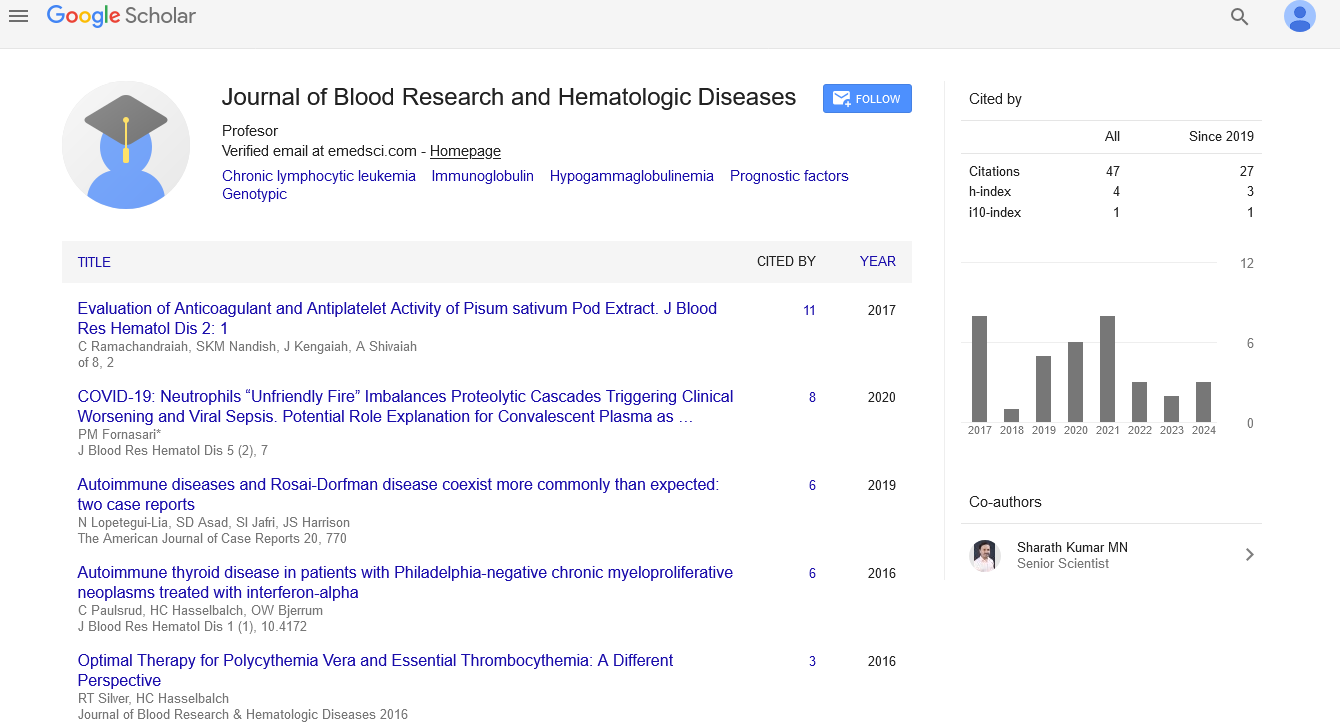Commentary, J Blood Res Hematol Dis Vol: 10 Issue: 1
Chronic Bleeding Conditions: Evaluating Risk Factors and Treatment Approaches
Satyrva Burugterkle*
Department of Oncology, St Jude Children's Research Hospital, Memphis, United States of America
*Corresponding Author: Satyrva Burugterkle
Department of Oncology, St Jude Children's Research Hospital, Memphis, United States of America
E-mail:satyrvaburu@gmail.com
Received date: 24 May, 2024, Manuscript No. JBRHD-24-137141;
Editor assigned date: 27 May, 2024, PreQC No. JBRHD-24-137141(PQ);
Reviewed date: 11 June, 2024, QC No. JBRHD-24-137141;
Revised date: 09 April, 2025, Manuscript No. JBRHD-24-137141(R);
Published date: 16 April, 2025, DOI: 10.4172/jbrhd.1000216
Citation: Burugterkle S (2025) Chronic Bleeding Conditions: Evaluating Risk Factors and Treatment Approaches. J Blood Res Hematol Dis 10:1.
Description
Chronic bleeding conditions encompass a spectrum of disorders characterized by prolonged or excessive bleeding, often stemming from abnormalities in blood clotting mechanisms. These conditions pose significant challenges in diagnosis, management, and treatment, requiring a thorough understanding of their underlying risk factors and targeted therapeutic strategies. This article explores the complexities of chronic bleeding conditions, examines key risk factors contributing to their development, and discusses current approaches to treatment.
Understanding chronic bleeding conditions
Chronic bleeding conditions refer to disorders where individuals experience persistent or recurring episodes of bleeding that are disproportionate to the level of injury or trauma. These conditions can affect both men and women of all ages and may vary in severity, ranging from mild bleeding tendencies to life-threatening hemorrhagic episodes. Common chronic bleeding disorders include hemophilia, von Willebrand disease, and acquired platelet function disorders.
Risk factors for chronic bleeding conditions
Several factors contribute to the development and severity of chronic bleeding disorders:
Genetic predisposition: Inherited genetic mutations affecting clotting factors, platelet function, or blood vessel integrity can predispose individuals to chronic bleeding disorders. Hemophilia A and B, for example, result from deficiencies in clotting factors VIII and IX, respectively.
Acquired disorders: Certain medical conditions or medications can lead to acquired bleeding disorders. Liver disease, vitamin K deficiency, and prolonged use of anticoagulant medications (e.g., warfarin, heparin) can impair blood clotting mechanisms and increase the risk of bleeding.
Age and gender: Some bleeding disorders, such as von Willebrand disease, may exhibit gender-specific differences in prevalence and severity. Age-related changes in blood vessel integrity and coagulation factor levels can also influence bleeding tendencies.
Environmental factors: Environmental factors such as diet (e.g., vitamin K intake), physical activity level, and exposure to toxins or infections can impact blood clotting function and contribute to bleeding disorders.
Diagnosis of chronic bleeding conditions
Diagnosing chronic bleeding disorders requires a comprehensive evaluation, including:
Medical history: Assessing personal and family history of bleeding episodes, including severity, frequency, and response to previous treatments.
Laboratory tests: Blood tests to evaluate clotting factor levels, platelet function, and specific genetic mutations associated with inherited bleeding disorders.
Imaging studies: Imaging techniques such as ultrasound or MRI may be used to assess internal bleeding or structural abnormalities in blood vessels.
Treatment approaches
The management of chronic bleeding conditions aims to control bleeding episodes, prevent complications, and improve quality of life. Treatment strategies may include:
Replacement therapies: For inherited bleeding disorders like hemophilia or von Willebrand disease, replacement therapies involve administering missing clotting factors or von Willebrand factor to restore normal hemostasis.
Desmopressin (DDAVP) therapy: This synthetic hormone is used to stimulate the release of von Willebrand factor and factor VIII in individuals with mild to moderate von Willebrand disease.
Antifibrinolytic agents: Medications such as tranexamic acid or aminocaproic acid inhibit the breakdown of blood clots and are used to manage bleeding episodes in certain bleeding disorders.
Platelet transfusions: In cases of severe platelet dysfunction or deficiency, transfusions of donor platelets may be necessary to support hemostasis.
Surgical interventions: Surgical procedures may be indicated to control or prevent bleeding complications, particularly in individuals with vascular malformations or structural abnormalities.
Research and future directions
Ongoing research in chronic bleeding disorders focuses on developing novel therapies, enhancing diagnostic accuracy, and improving patient outcomes. Advances in gene therapy, personalized medicine, and the use of recombinant clotting factors offer promising avenues for more targeted and effective treatment approaches.
Conclusion
In conclusion, chronic bleeding conditions represent a diverse group of disorders characterized by abnormal blood clotting mechanisms and increased bleeding tendencies. Effective management requires a multidisciplinary approach, involving collaboration between hematologists, geneticists, and other healthcare professionals. By understanding the underlying risk factors, leveraging diagnostic tools, and implementing tailored treatment strategies, clinicians can optimize care and improve the quality of life for individuals living with chronic bleeding disorders. Continued research and innovation are essential for advancing our understanding of these complex conditions and further enhancing therapeutic options in the field of hematology.
 Spanish
Spanish  Chinese
Chinese  Russian
Russian  German
German  French
French  Japanese
Japanese  Portuguese
Portuguese  Hindi
Hindi 